
The Trait Breton is a French breed of draught horse. It originated in Brittany, in north-west France, from cross-breeding of local horses with various other breeds. It is strong and muscular, and often has a chestnut coat.

The Landais is a critically-endangered French breed of small horse or pony. It originated in the marshy plains and woodlands of the département of the Landes, in the Nouvelle-Aquitaine region of south-western France, but is more often reared in the département of Pyrénées-Atlantiques, particularly in the arrondissement of Pau. Due to influences from Arab and Welsh blood, it shows more similarity to Oriental horses than to other Celtic breeds. It is used for riding and driving, and is a good trotter.
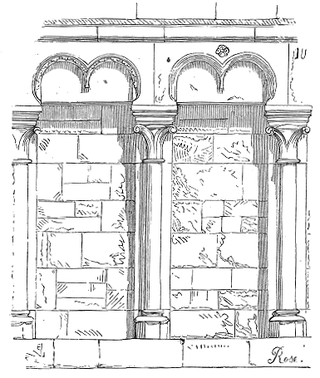
The Abbey of Montier-en-Der in Haute-Marne, France, was formerly a Benedictine, later Cluniac, abbey, dissolved during the French Revolution, the grounds and premises of which, since 1806, have been used as the French National Stud Farm.

Viscount Antoine Henri Philippe Léon Cartier d'Aure was a French riding-master, and author of important treatises on dressage. He was écuyer en chef of the Cadre Noir of Saumur, and later to the Emperor of France, Napoléon III. He was made an officer of the Légion d'Honneur in 1849.

The Poitevin or Poitou is a French breed of draft horse. It is named for its area of origin, the former province of Poitou in west-central France, now a part of the region of Nouvelle-Aquitaine. It was formed in the seventeenth century when horses of Flemish or Dutch origin, brought to the area by engineers working to drain the Marais Poitevin, interbred with local horses. Although it has the size and conformation of a draft horse, the Poitevin has never been bred for draft abilities, and has been little used for draft work. Its principal traditional use was the production of mules. Poitevin mares were put to jacks of the large Baudet du Poitou breed of donkey; the resulting Poitevin mules were in demand for agricultural and other work in many parts of the world, including Russia and the United States. In the early twentieth century there were some 50,000 brood mares producing between 18,000 and 20,000 mules per year.

Le Pin-au-Haras is a commune in the Orne department in north-western France.
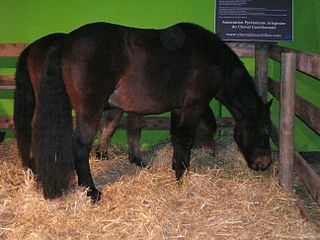
The Castillonais or Cheval Ariègeois de Castillon , also formerly called Cheval du Biros or Saint-Gironnais, is an ancient breed of small rustic saddle-horse from the Ariège département of south-western France. It may be dark bay or seal brown. It stands 135–155 centimetres at the withers, with an average height of about 145 cm. It is used principally for trekking and for driving.

The Norman Cob or Cob Normand is a breed of light draught horse that originated in the region of Normandy in northern France. It is of medium size, with a range of heights and weights, due to selective breeding for a wide range of uses. Its conformation is similar to a robust Thoroughbred, and it more closely resembles a Thoroughbred cross than other French draught breeds. The breed is known for its lively, long-striding trot. Common colours include chestnut, bay and seal brown. There are three general subsets within the breed: horses used under saddle, those used in harness, and those destined for meat production. It is popular for recreational and competitive driving, representing France internationally in the latter, and is also used for several riding disciplines.

The Henson horse, or cheval de Henson, is a modern horse breed from northwest France. It was created by the selective breeding of light saddle horses with the smaller, heavier Norwegian Fjord horse to create small horses suitable for the equestrian vacation industry. The breeders' association, Association du Cheval Henson, was formed in 1983. In 1995 the studbook was closed to horses not born from Henson parents, and in 2003 the breed was officially recognised by the French government agencies for horse breeding. A hardy breed of horse, each winter the broodmares and youngstock from several breeders are let loose together to graze freely in the wetland reserves in France.

The Charentais and Vendéen are extinct breeds of horse from western France. They were bred principally in the area around Poitou-Charentes and Vendée, France. They were used as a mount for light cavalry.

The Haras national du Pin is a French national stud located in Le Pin-au-Haras district, in the Orne (61) department of the southern Normandy region. It is the oldest of the French "Haras Nationaux".
Kheir is a gray Barb horse, born in 2004 at the National Stud of Chaouchaoua in Algeria, and then given as a diplomatic gift to the French President Nicolas Sarkozy in 2007. He was subsequently sent to the National Stud of Les Bréviaires in France and trained for equestrian shows.
The National Stud Farm of Chaouchaoua is a stud-farm in Tiaret, Algeria. Established in 1874, its primary focus is the preservation and improvement of Algerian horse breeds.

Fuschia was a trotter horse born in the Manche region of France, and head of the French Trotter breed. Winner of 17 of the 20 races in which he competed in mounted trotting from age 3 to age 5, he is best known for having been an excellent sire at the Le Pin national stud, to the point of imposing for the first time a lottery system for the allocation of breeding rights to brood mares.
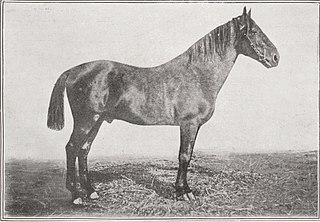
Niger was a trotter horse originated from a lineage of the now-extinct French Trotter breed. A son of The Norfolk Phœnomenon, he was a grandson or great-grandson of the English stallion The Norfolk Phenomenon. His dam, Miss Bell, was a half-blood mare of English or American origin, reputed to have served Napoleon III.
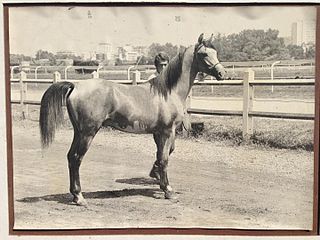
Persik, born on 1 April 1969 and died on 24 August 2001, was a gray-coated Arabian horse who was the leading sire in the equestrian discipline of endurance from 1975 until his death in 2001. His eclectic origins include Polish and Russian bloodlines, as well as French and English, in particular the famous Skowronek. Purchased in 1973 from the Tersk stud farm, Persik was imported to France by Jean Cougul, a breeder from Vigoulet-Auzil, then bought by the Cévennes National Park with the aim of breeding horses suitable for trail riding. In 1975, Persik won the first edition of a well-known endurance race, the 130 km de Florac.

The Norfolk Phœnomenon is a black-coated stallion of the Norfolk Trotter breed. He is a son or grandson of the most famous English trotter stallion of his time, The Norfolk Phenomenon. He was imported to France in 1851 on a mission from the Haras Nationaux.

The Haras National de Lamballe is one of five equestrian centers in the French region of Brittany. Established in the autumn of 1783, it originally functioned as a depot for royal stallions, operating from a single stable within a barracks in the town of Lamballe. Although it was abolished in 1790 and briefly recreated in 1825, the national stud assumed its definitive form in 1842, tasked with providing breeding stallions to the owners of approximately 70,000 broodmares in its district. Numerous extensions led to the construction of eleven new stables until the beginning of the 20th century, housing up to 350 stallions of all breeds. The National Stud played a major role in the development of the Norfolk-Breton breed, the future Breton horse, by importing Norfolk Trotter stallions from England. It was also responsible for the success of the half-Ardennes stallion Naous, one of the founding stallions of the Breton horse breed.
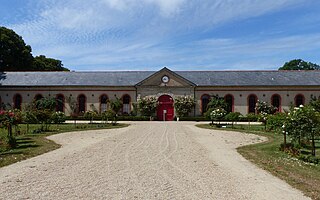
The Haras National d'Hennebont is one of five equestrian centers in the French region of Brittany. It was created in 1856 in Hennebont, Morbihan, around the former Abbey of La Joie, as a result of an exchange with the Abbey of Notre-Dame de Langonnet. Inaugurated by Napoleon III on August 15, 1858, it was classified as a historic monument in 1995.

The National Equestrian School in France, École nationale d'équitation (ENE), is a public establishment created in 1972 around the Cadre Noir in Saumur with the aim of training senior equestrian executives. In 2010, it merged with Haras Nationaux to form the Institut français du cheval et de l'équitation.



















